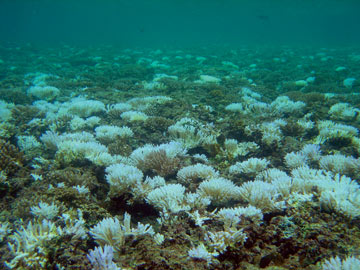|
NEWS NOTES
Corals safer in warm ocean pools
 David Burdick, Courtesy of NOAA |
| Rising sea-surface temperatures have caused mass bleaching among corals worldwide, such as this reef near Guam. |
With sea-surface temperatures expected to continue to rise, scientists fear that coral reef ecosystems will be increasingly vulnerable to “mass bleaching.” But there may be hope for certain corals already inhabiting the warmest parts of the ocean, says Joanie Kleypas, a marine ecologist at the National Center for Atmospheric Research in Boulder, Colo. The ocean, she says, may have a built-in “thermostat” that won’t let it get much warmer.
Higher ocean temperatures worldwide have already had a significant impact on corals. Normally, corals shelter symbiotic algae called zooxanthellae, which photosynthesize sunlight into sugars that feed the corals. As ocean temperatures rise, however, corals begin to expel their zooxanthellae. Because the algae also lend their pigments to the corals, the vacated corals appear whitened, or “bleached.” If the zooxanthellae are gone for too long and the bleaching is prolonged, the corals can die.
The “ocean thermostat,” however, may limit some of that bleaching. A combination of several atmosphere-ocean interactions, including evaporation, cloud formation and ocean circulation and currents, act to remove heat from the oceans, like a kind of thermostat, Kleypas says. These mechanisms may also remove even more heat as temperatures continue to rise, thereby keeping sea-surface temperatures from increasing beyond 30 to 31 degrees Celsius, she says.
Still, although scientists agree that these cooling mechanisms exist, it’s not clear how effective these interactions are at keeping temperatures in check. For corals, the question could be a vital one — coral reefs in already-warm areas of the ocean are accustomed to high temperatures, but would suffer if they continued to increase. One such area is the western Pacific warm pool, a large section of ocean off the northeastern coast of Australia where sea-surface temperatures never dip below 28 degrees Celsius. Kleypas and her team noticed that although sea-surface temperatures had increased around the world since 1950, temperatures in the already-balmy western Pacific warm pool have risen by only half as much as other regions.
Furthermore, they found that mass bleaching events were much less devastating to coral reefs in the western Pacific warm pool than in other parts of the world. Although coral bleaching has affected more than 50 percent of reefs in some parts of the world, it has affected half as many reefs near the Pacific Islands of Polynesia, Micronesia and Melanesia. In fact, when comparing the number of bleaching reports with average sea-surface temperatures for different reefs, those in the warmest regions suffered least, the researchers reported Feb. 9 in Geophysical Research Letters.
That suggests that the ocean thermostat mechanisms are keeping those temperatures in check, Kleypas says. Her team also ran models of the western Pacific warm pool to calculate how it might heat up as temperatures continue to rise, and found the same result, which suggests the pattern is “not a fluke,” she says.
The finding is an important step forward, says Robert Buddemeier, a geologist at the Kansas Geological Survey in Lawrence. “There’s been recognition of the idea of a thermostat for some time, but it’s not something that has been rigorously explained or demonstrated,” Buddemeier says. “It might suggest you’ve got better opportunities for long-term conservation in [warmer] areas,” he says. That idea — that the warmest places in the ocean might be safest for corals — is somewhat counterintuitive, he notes, and scientists and conservationists will need to “rethink the question of vulnerability, and be looking harder at protecting areas in the true central tropics.”
Kleypas echoes that sentiment. “We’re going to have to live with some climate change, unfortunately,” and tough decisions may soon have to be made about where to put resources, she says. “Let’s say you have a garden, and you’re experiencing drought and water rationing. Do you try to save everything, or the things you can? If there are places where we could have a [higher] success rate at saving coral reefs, then we should start looking for them.”

 Subscribe
Subscribe


